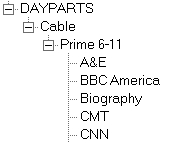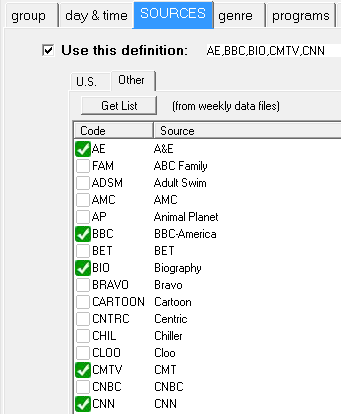How Long Does it Take?
A tremendous amount of work is needed to collect all of the audience data needed to fit your specifications for a new television audience database. So, yes, it can take a while. Let's look at some tips on how to minimize or reduce this time.
You Do NOT Need a New Database for Every Project
The design of TView anticipates that plansheets, where the nitty-gritty of reach and frequency and plan development occurs, will be used frequently, while constructing new databases will be done once in a while.
If a database is sufficiently rich in daypart and network choices, then it will serve as the data foundation for lots of R&F and planning investigations. The trick, of course, is to have a nice set of rich databases ready to be used.
Creating Stock TVD Databases for Everyone to Use
We provide several sample scripts that create juicy, rich databases with lots of daypart choices. Just go to the File menu, and choose "Open Sample Script".
It is a great practice to create a fresh TVD with lots of dayparts for each new quarter of data. You may also like to have a stock TVD for major months, such as sweep months, or maybe even all months as new data arrives.
If you are creating TVD databases for general use, give them names that clearly indicate what they contain, such as "2012 Q2" or "2012 Feb".
Then put them in a location that everyone can access. You can arrange to have all general use databases visible in a special "Common databases" location, and the choice appears to users like this when starting a new plansheet:

To set this up, your IT people can use the "tvd=" definition in the system's INI file, and that's all described in the page about INI Settings.
Your Company Network
In building a TVD database, an awful lot of information is passed along your company network. How your network is configured can have a big effect on the time it takes to build a TVD database. If different people in different locations seem to be experiencing very different time requirements, your IT people may wish to take a look into that.
Number of Weeks
It takes roughly three times as long to assemble the data from 12 weeks than it does from 4 weeks.
Do NOT Put Networks on Separate Lines in a Script!
Every line in a script file is handled by a separate pass through the data. Consider these script lines:

Five separate lines are used for five networks. Each line uses the "Sources" tab to denote one network. So this requires five separate passes through the data, and that takes time.
This is much faster: Just create a single line for "Prime 6-11", and specify all of the desired networks:
|
|
But you might say, "But I want to be able to plan with distinct individual networks on the plansheet".
Well, you still can. Remember that when you place a daypart on a plansheet, you are asked for the networks to be included, and you get this interesting choice:
![]()
Just click "OK (each on its own line)" to create a separate line for each network. QED!


